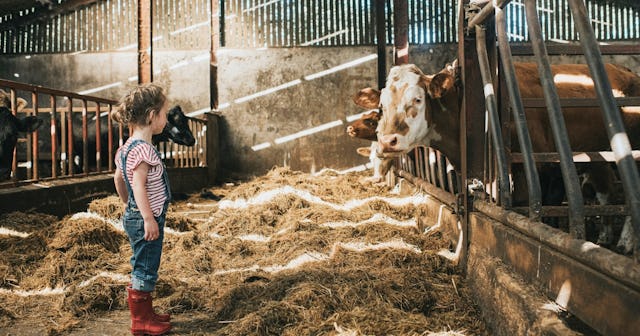11 Farm Coloring Pages That Are Outstanding In Their Field

Old MacDonald, the “farmer in the dell,” Aunt Em in The Wizard of Oz, Kevin Costner in Field of Dreams — these examples are just a few of the many, many beloved farmer characters in nursery rhymes and onscreen. Why do we love farmers so much? Well, for starters, without farmers, we wouldn’t have delicious food on our table. The word farmer usually refers to a person who has a field, orchard, vineyard, or garden where food is grown. Farming has been dated back as far as 5000 to 4000 B.C.E., and thanks to the recent homesteading trend (can you say pet chickens?), respect and appreciation for farming feel higher than ever. Plus, learning about farming is so vital for kids in understanding where they get their food. So, in celebration of farms, we decided to put together some fun farm coloring pages. Bonus: Even on days you can’t make a field trip to visit an actual farm, these free printables make a perfect at-home activity for you and the kids. Who knows? After coloring them, you might want to start your own little homestead.
In fact, if you’re living in the suburbs but dreaming of life on the farm, we’ve got a whole farmyard full of free printables for you. When you finish filling in these fine fowls, move on over to our goat coloring pages, pig coloring pages, cow coloring pages, horse coloring pages, and garden coloring pages.
Free Printable Farm Coloring Pages
Farm Page No. 1
When we think of farming, we probably think of cute animals. However, the most popular crops farmed globally are corn, rice, cotton, and wheat. And did you know there are several kinds of farming? This includes subsistence farming, mixed farming, nomadic herding, commercial plantation, livestock rearing, and more.
Farm Page No. 2
In the U.S., back in the 1930s, one farmer fed only himself and three other consumers. Now, thanks to technology, that same farmer feeds well over a hundred people, if not more.
Farm Page No. 3
Abraham Lincoln created the U.S. Department of Agriculture in 1862 because almost everyone in America was a farmer at the time. In fact, about 90 out of every 100 Americans were farmers. Today, only two out of every 100 Americans are farmers.
Farm Page No. 4
Farming is more than just growing and gathering food. Farming teaches life skills like working hard, communicating, caring for others, and respecting Mother Nature. You also come to see food as not something to waste but something to appreciate. When you grow your own food, you’re less likely to create waste. You see it not just something to consume but as a reward after a hard day’s (or season’s) work.
Farm Page No. 5
According to the USDA, female farmers have been increasing. In 2017, the United States had 1.2 million female food producers, accounting for 36 percent of the country’s farmers. Today’s female farmers tend to be slightly younger than their male counterparts and are more likely to be beginning farmers who live on their farms.
Farm Page No. 6
Farming also teaches respect for the circle of life, especially when it comes to livestock. One of the most difficult aspects of farming is that many animals will perish so we can eat them. Acknowledging the life of the animals we eat helps us see the joys and sadness of life’s cycles and sacrifices.
Farm Page No. 7
It typically takes a farmer 20 minutes to milk a cow, and it’s done about two or three times a day on average. This dairy cow can produce 1,500 gallons of milk in a single year. Impressive!
Farm Page No. 8
Seeds typically take one to two weeks to germinate (sprout). You might want to grow your own with your little ones to show them firsthand the process of germination.
Farm Page No. 9
Vegetables come from flowers and seeds. Most vegetables need warm weather to grow, but some veggies — like spinach, lettuce, carrots, and turnips — can grow in cold weather.
Farm Page No. 10
Farming, like life, just takes a single seed to grow. With a little bit of dedication and nourishment, beautiful things can be made one step, one season, at a time.
Farm Page No. 11
Have you ever seen a tumbleweed? Well, we count three in this picture. OK, OK, so maybe these are hay rolls. But like sort of look like giant tumbleweeds, don’t they? One way to tell the difference between the two is how long it takes for them to break down, as that process can take years with tumbleweeds. They actually come from a plant that eventually dries up and breaks away from its roots. That’s why they’re so mobile.
Click here to print all of the farm coloring pages at once!
This article was originally published on